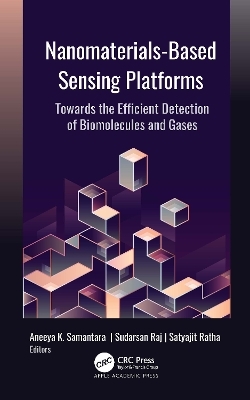
Nanomaterials-Based Sensing Platforms
Apple Academic Press Inc. (Verlag)
978-1-77463-859-0 (ISBN)
Sensors are effective tools used to carry out cost-effective, fast, and reliable sensing for a wide range of applications. This volume presents a brief history behind sensing technology and highlights a broad range of biosensing techniques based on optical and electrochemical response methods. Starting from the traditional enzyme-based biosensing method to functionalized nanostructure-based sensors, this book also provides a detailed overview of some of the advanced sensing methodologies based on photonic crystal cavity-based sensing devices.
The authors showcase the extraordinary success of nanomaterials, their current strategical exploitation, and an unprecedented pool of possibilities they hold for the future. Many of the technologies have been developed recently for the sensing of various bioanalytes and molecules, some of which have been included in this book through dedicated chapters. The book looks at various sensors, such as for biosensing, electrochemical sensing, gas sensing, photoelectrochemical sensing, and colorimetric sensing, all of which have shown vast potential.
Aneeya K. Samantara, PhD, is a national postdoctorate fellow at the National Institute of Science Education and Research, Odisha, India. Dr. Samantara’s research interests include the synthesis of metal chalcogenides and graphene composites for energy storage/conversion applications and designing of electrochemical sensors for detection of different bioanalytes. To his credit, he has authored over 25 peer-reviewed papers published in international journals, as well as books and book chapters. Sudarsan Raj, PhD, is currently working as a research associate at the CSIR-Institute of-Minerals and Materials Technology, Odisha, India. He was previously a postdoctoral research scientist at Nagoya University, Japan. His research output includes a number of authored and coauthored peer-reviewed journal articles and book chapters. His research interests include nanoparticle synthesis for LEDs, solar cells, gas sensors, automobile exhaust catalysts, and value-added-beach sand minerals. Satyajit Ratha, PhD, has pursued his PhD at the Indian Institute of Technology Bhubaneswar, India. Prior to joining IIT Bhubaneswar, he received his Bachelor of Science with first class honors from Utkal University and his Master of Science from Ravenshaw University. His research interests include two-dimensional semiconductors, nanostructure synthesis applications, energy storage devices, and supercapacitors. He has authored and co-authored over 20 peer-reviewed papers published in international journals and 10 books.
1. Biosensors: Current Trends and Future Perspectives 2. Functionalized Nanomaterials for Biosensing Application 3. Photonic Crystal Cavity-Based Sensors and Their Potential Applications 4. Metal Oxide Nanostructures for Gas Sensing Applications 5. Optical Biosensors for Diagnostic Applications 6. Metal-Free Electrode Materials for Electrochemical Biosensors 7. Noble Metal Nanoparticles-Based Composites for Gas Sensing: Progress and Perspective 8. Nanoparticles: A Noble Metal for Ultrasensitive Electrochemical Biosensing Affinity
| Erscheinungsdatum | 04.11.2021 |
|---|---|
| Zusatzinfo | 11 Tables, black and white; 11 Line drawings, color; 53 Line drawings, black and white; 10 Halftones, color; 14 Halftones, black and white; 21 Illustrations, color; 67 Illustrations, black and white |
| Verlagsort | Oakville |
| Sprache | englisch |
| Maße | 152 x 229 mm |
| Gewicht | 566 g |
| Themenwelt | Medizin / Pharmazie ► Gesundheitswesen |
| ISBN-10 | 1-77463-859-2 / 1774638592 |
| ISBN-13 | 978-1-77463-859-0 / 9781774638590 |
| Zustand | Neuware |
| Haben Sie eine Frage zum Produkt? |
aus dem Bereich


